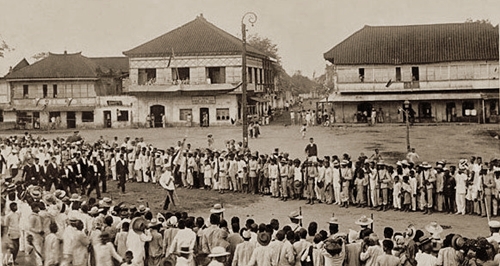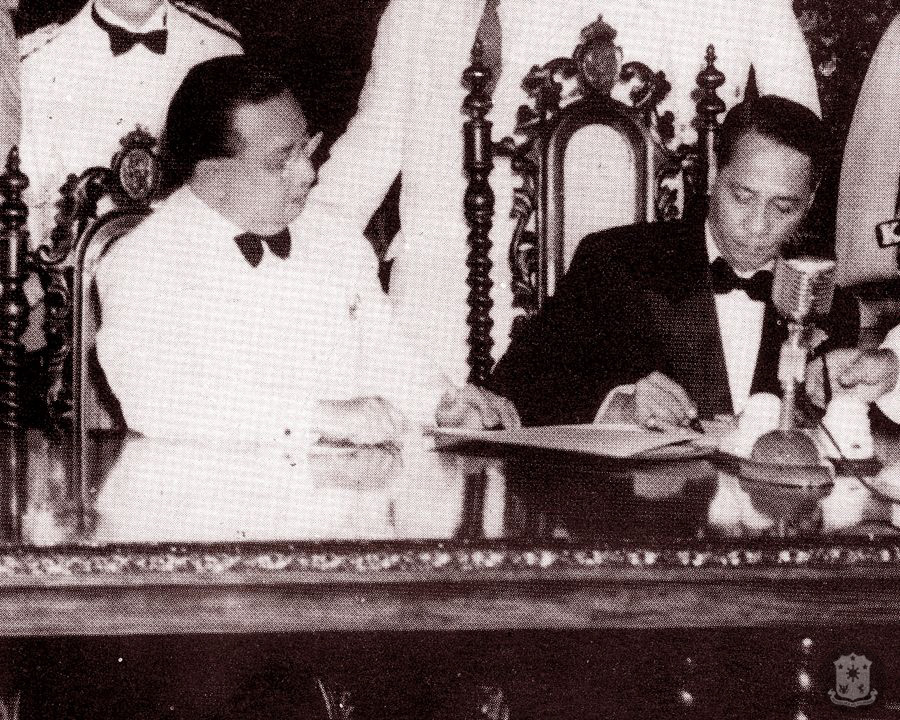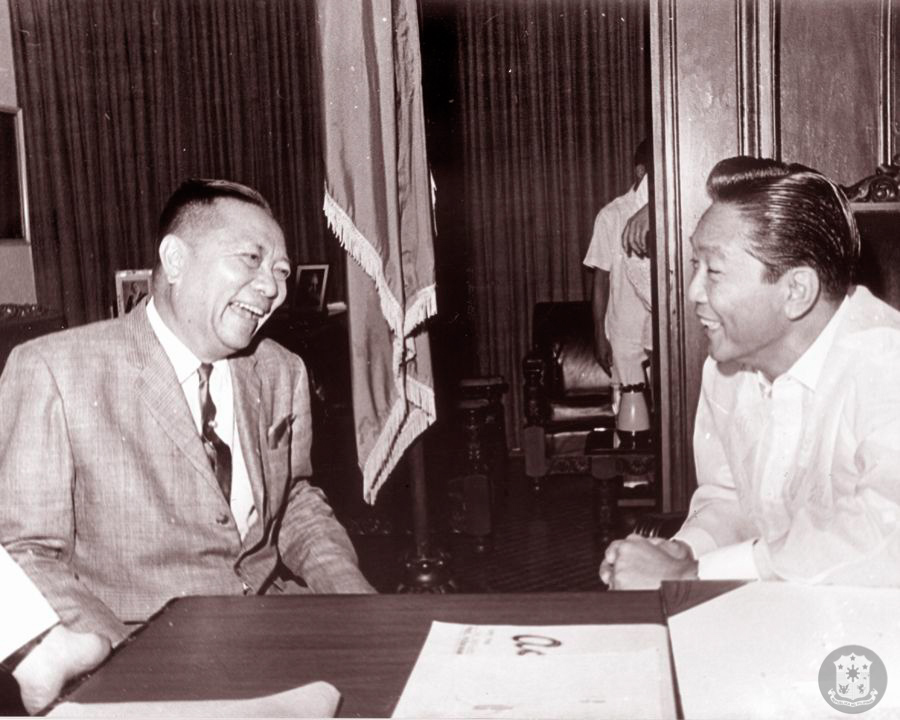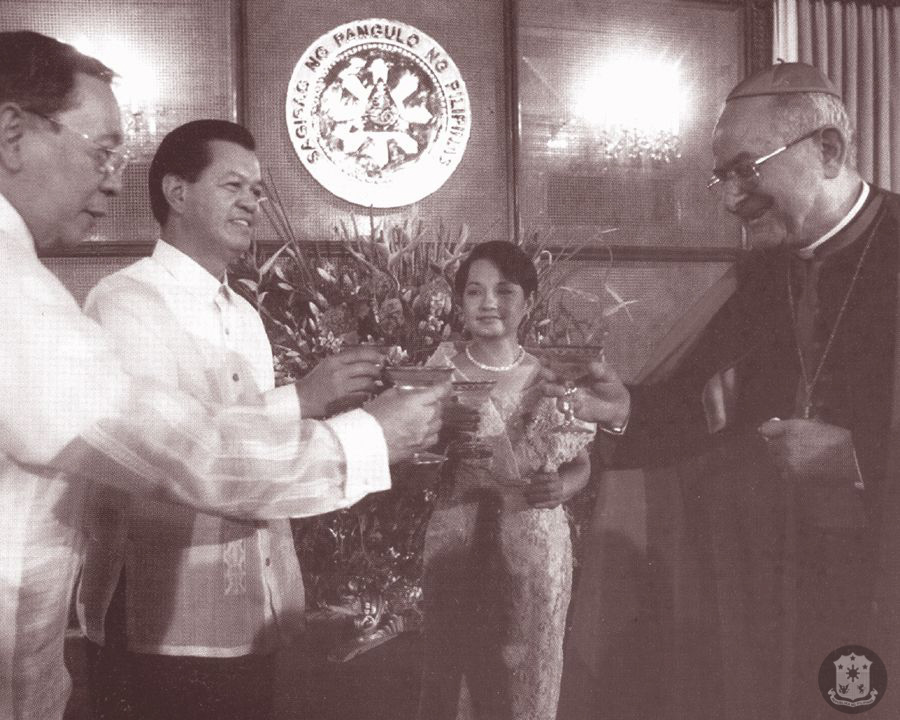The History of the Philippine Vice Presidency - Chronology of Vice Presidents

(Inauguration of the First Philippine Republic, Jan. 23, 1899. Photo courtesy of Presidential Museum and Library)
We trace the roots of the history of the Philippine Republic from the First Republic.
Established in Malolos, Bulacan on September 15, 1898, the revolutionary congress in Malolos started drafting a constitution for the Philippines, which won its freedom June 12 of the same year. The draft constitution, later known as the Malolos Constitution, was finally ratified and promulgated in January of 1899 with Emilio Aguinaldo as President of the First Philippine Republic.
This charter did not provide for a position of Vice President, instead it vested upon the President of the Supreme Court of Justice (the Chief Justice) the responsibility of discharging the powers of the Office of the President should a President be unable to perform his duties. The First Philippine Republic was dissolved in 1901 with the end of the Philippine American War.
The position of Vice President of the Philippines was formally created on November 15, 1935, with the inauguration of the Commonwealth of the Philippines.

(President Manuel L. Quezon with Vice President Sergio Osmeña. Photo courtesy of Presidential Museum and Library)
Sergio Osmeña Sr. (1935 – 1944)
The 1935 Constitution provided for an Office of the Vice President which was initially held by Sergio Osmeña who won with 87% of the vote. Elected on September 16, 1935, Sergio Osmena Sr became the first Visayan vice president under the Quezon presidency. The Quezon-Osmena tandem lead to the birth of the Philippine Commonwealth, where Osmena also served as the secretary of the Public Instruction, later named to be the Department of Education.
Osmeña served as Vice President to President Manuel L. Quezon for three terms. First from 1935 to 1941, second from 1941 to 1943, and finally from 1943 to August 1, 1944 – when his term was extended due to World War II, and he succeeded President Quezon who passed away.
During World War II, the Commonwealth of the Philippines was exiled to the United States. Parallel to this, a different government, sponsored by the Japanese, was established in the country. The Second Philippine Republic was inaugurated on October 14, 1943, with Jose P. Laurel as President. It had a different constitution which did not provide for a Philippine Vice President. The Second Republic was formally dissolved on August 17, 1945, with the surrender of the Japanese to the Americans.
After World War II, the Philippine Commonwealth was reestablished with Sergio Osmeña as President and a vacant Vice Presidency. In accordance to granting the Philippines independence, the American Congress adopted a Joint Resolution, setting the date for the elections for the Philippine government not later than April 30, 1946. President Osmeña approved Commonwealth Act 725 calling for a national election in accordance with the American Joint Resolution. The election was held on April 23, 1946, with Manuel Roxas winning the Presidency and Elpidio Quirino winning the Vice Presidency. Quirino became the Second Vice President of the Philippines.

(Vice President and Secretary of Foreign Affairs Elpidio Quirino looks on as President Manuel Roxas signs the Treaty of General Relations in the Reception Hall of Malacañang Palace. Photo courtesy of Presidential Museum and Library)
Elpidio Quirino (1946 – 1948)
Former senator and Interior and Finance Secretary Elpidio Quirino was inaugurated on July 4, 1946, as the Vice President of an independent Philippines – the third Philippine Republic. Quirino served as then President Manuel Roxas’ Vice President until April 15, 1948, when he succeeded to the Presidency after Roxas’ sudden demise.
During his short stint as the Vice President, Elpidio Quirino also served as the Secretary of Foreign Affairs, where the Philippines was able to establish ties with foreign countries. The country also became a member of reputable international organizations including United Nations General Assembly, the United Nations Educational, Scientific and Cultural Organization (UNESCO), the World Health Organization (WHO), and the International Labor Organization (ILO).

(President Elpidio Quirino with Vice President Fernando Lopez. Photo courtesy of Presidential Museum and Library)
Fernando Lopez (1949 – 1953)
The position of Vice President would remain vacant until 1949 when the next national elections were scheduled. On November 8, 1949, Elpidio Quirino and Fernando Lopez won the Presidency and Vice Presidency, respectively.
Fernando Lopez became the vice president in 1949, where he also served as the secretary of Agriculture until 1953. He was reelected as vice president in 1969. During his term as vice president and agriculture secretary, he was dubbed as the “rice czar” for his contribution to the distribution of the Miracle Rice.
Fernando Lopez served as the third Vice President of the Philippines until 1953. He was not renominated by his party and did not run for re-election.

(President Ramon Magsaysay with Vice President Carlos P. Garcia. Photo courtesy of Presidential Museum and Library)
Carlos P. Garcia (1953 – 1957)
Senator Carlos P. Garcia was elected as the fourth Vice President of the Philippines in 1953, attaining 62% of the vote. He also served as the Secretary of Foreign affairs from 1953 to 1957. Under his term, several peace treaties and war reparations with the Japanese were created. He also continued foreign policies and spearheaded the Southeast Asia Treaty Organization (SEATO) in 1954.
Garcia served as Ramon Magsaysay’s Vice President until the President died in a plane crash in Cebu on March 17, 1957.Garcia took his oath as President the next day. At the time, he was away on official business and had to travel back to the Philippines immediately to assume the Presidency.

(Vice President Diosdado Macapagal with President Carlos P. Garcia. Photo courtesy of Presidential Museum and Library)
Diosdado Macapagal (1957 – 1961)
Elections were set the same year that Magsaysay was killed in a plane crash. In those elections, Garcia ran and won the Presidency but his running mate, House Speaker Jose B. Laurel, Jr., lost the election for Vice President. This was the first instance in the history of the Philippines where the top two officials of the land came from different parties.
Diosdado Macapagal became the first Philippine vice president to be elected from the president’s rival party, and he served as the leader of the opposition for his entire term. He won with 46% of the vote and became the fifth Vice President of the Philippines.
He was refused a Cabinet position under the Garcia administration but was later offered a position on one condition that he switches allegiance to the Nationalista Party. As the Garcia administration’s major critic of policies and performances, he spent his term frequently visiting the countryside to meet with voters.
Macapagal served as Garcia’s Vice President until 1961 when he challenged Garcia’s reelection bid.

(Vice President Emmanuel Pelaez with President Diosdado Macapagal. Photo courtesy of Presidential Museum and Library)
Emmanuel Pelaez (1961 – 1965)
During the 1961 elections, Diosdado Macapagal, the incumbent Vice President, went on to win the Presidency and his running mate Emmanuel Pelaez became the sixth Vice President of the Philippines. Pelaez won with a plurality of votes getting a total of 38%. He also served as the Foreign Affairs Secretary from 1961 to 1963, when he was given the power of authority to formally accept the transfer of sovereignty over North Borneo from the Sultan of Sulu.
Vice President Pelaez eventually left the Liberal Party and joined the Nationalista Party to vie for the party’s nomination for President. The party, however, nominated Senate President Ferdinand Marcos to run as President and incumbent Senator and former Vice President Fernando Lopez to run as Vice President.

(Vice President Diosdado Macapagal with President Carlos P. Garcia. Photo courtesy of Presidential Museum and Library)
Fernando Lopez (1965 – 1972)
In the elections of 1965, Marcos and Lopez came out on top against incumbent President Macapagal. Lopez won by a plurality of votes, getting 48% of the total votes cast. Lopez served as the seventh Vice President of the Philippines until the imposition of Martial Law in 1972.
At the time of Martial Law, the Philippine Legislature was closed, and the Vice Presidency was abolished. Moves to change the Constitution came to a head with the ratification of the 1973 Constitution which re-established a unicameral legislature and completely abolished the Vice Presidency. It was not until 1984 when amendments to the 1973 Constitution were approved through a referendum that the Office of the Vice President was reestablished.

(President Corazon C. Aquino with Vice President Salvador "Doy" Laurel. Photo courtesy of Presidential Museum and Library)
Salvador Laurel (1986 – 1992)
The first election for Vice President since 1969 was set for 1987 but was done in February of 1986 when President Marcos called for a snap election. In that election, Salvador Laurel won against rival Arturo Tolentino with 51% of the vote –making him the eighth Vice President of the Philippines.
The subsequent EDSA Revolution would eventually repeal the 1973 Constitution and put in place our current constitution in 1987. It re-established the Vice Presidency and a bicameral legislature.
During his term as Vice President under the Aquino administration, Salvador Laurel also served as Foreign Affairs Secretary. He focused on a policy that aimed to get recognition from other states, which led to the United States of America providing the country with both economic and military assistance. Under his leadership, the Philippines hosted the ASEAN Summit Convention despite lingering turmoil and unrest.

(President Fidel V. Ramos with Vice President Joseph Estrada. Photo courtesy of Presidential Museum and Library)
Joseph Estrada (1992 – 1998)
On May 11, 1992, the first Presidential election under the 1987 Constitution was held. This election used to hold the record for the most number of candidates who ran for the Vice Presidency. Out of the seven candidates, Joseph Estrada won with 33% of the vote. Estrada served as the ninth Vice President of the Philippines until he ran for President in 1998.
Vice President Estrada also served as the Chairman of the Presidential Anti-Crime Commission from 1992 to 1997. Under his leadership of the Commission, safehouses were raided by special units and the arrest of criminal warlords and kidnapping syndicates were covered by the national press. In 1993, VP Estrada was named as "Man of the Year" by ABS-CBN Broadcasting Corporation after he consistently topped the Social Weather Station's surveys on government official’s performance.

(Vice President Gloria Macapagal-Arroyo with President Joseph Estrada. Photo courtesy of Presidential Museum and Library)
Gloria Macapagal Arroyo (1998 – 2001)
The 1998 elections also saw a high number of candidates vying for the Vice Presidency. Out of the 7 candidates, Gloria Macapagal Arroyo won the elections garnering 50% of the vote. Arroyo took office in 1998 along with President Joseph Estrada. Apart from becoming the Vice President, Gloria Macapagal Arroyo also served as the Social Welfare and Development Secretary, but later resigned in 2000 following the Executive Order No. 15 issued by President Estrada, which essentially transformed the cabinet office’s mandate and role.
She was the tenth Vice President of the Philippines and assumed the Presidency after President Estrada resigned in 2001.

(Vice President Teofisto Guingona with President Gloria Arroyo. Photo courtesy of Presidential Museum and Library)
Teofisto Guingona Jr. (2001 – 2004)
VP Guingona is known for his strong stance against graft and corruption and culpable violations of the Constitution. He was the first to call on President Joseph Estrada’s resignation and was also one of the leaders in opposing the Marcos regime.
With the Vice Presidency vacant in 2001, President Arroyo nominated her party mate and incumbent Senator Teofisto Guingona. His nomination was affirmed by the Congress of the Philippines, and he became the 11th Vice President of the Philippines. He served as President Arroyo’s Vice President until 2004 when he did not run for reelection. He was also the Secretary of Foreign Affairs from 2001 to 2002, following a resignation that “stemmed from an honest difference of opinion concerning policy”.

(Vice President Noli De Castro with President Gloria Macapagal-Arroyo. Photo courtesy of Presidential Museum and Library)
Noli de Castro (2004 – 2010)
President Arroyo chose independent Senator Noli de Castro as her running mate in the 2004 elections. Both won the Presidency and the Vice Presidency respectively. With 50% of the vote, de Castro went on to be the 12th Vice President of the Philippines.
Vice President Noli de Castro served as the Housing and Urban Development Council Chairman during his term. This provided him with the opportunity to serve the Housing and Land Use Regulatory Board, National Housing Authority, Home Guaranty Corporation, National Home Mortgage Finance Corporation, and the Social Housing Finance Corporation.

(Vice President Jejomar Binay with President Benigno S. Aquino III. Photo courtesy of Presidential Communications Operations Office)
Jejomar Binay (2010 – 2016)
De Castro served until 2010 and was succeeded by Vice President Jejomar Binay, the 13th Vice President of the Philippines. During his term, Vice President Jojo Binay also served as the Chairman of the Housing and Urban Development Council and Presidential Adviser on Overseas Filipino Workers.
Under VP Binay, the OVP claimed to have served 56,722 Filipinos through medical, burial, and transportation assistance from July 2010 to March 2016. In addition, the office has also provided around 642,143 families with relief assistance and 124,416 children of indigenous groups with educational support. The office’s medical and dental checkup also covered 143,251 beneficiaries.

(Vice President Leni Robredo with President Rodrigo Duterte. Photo courtesy of OVP)
Leni Robredo (2016 – 2022)
In the 2016 elections, Davao Mayor Rodrigo Duterte won as President while Camarines Sur Third District Representative Leni Robredo won as Vice President. Garnering 35% of the vote, Vice President Robredo became the first congresswoman to win the Vice Presidency. She was also appointed as ICAD co-chair in 2019, but only held office for 18 days due to internal conflicts that reported made it “impossible for me to perform my duties.”
Vice President Robredo went on to continue her work under the Angat Buhay and further stepped up during the peak of the COVID-19 pandemic, responding to public need as demanded.
Under her term, the Office of the Vice President also achieved and maintained International Organization for Standardization (ISO 9001:2015). Moreover, the Commission on Audit has also awarded the OVP an unqualified opinion for financial reports in 2018, 2019, 2020, and 2021.

Sara Duterte (2022 – present)
Daughter of then President, Rodrigo Duterte and former Davao City Mayor, Sara Duterte won as the 15th Vice President of the Philippines in the 2022 national elections. VP Duterte was also appointed by President Ferdinand Marcos Jr. as secretary of the Department of Education.
History recorded not just the fate of the Vice Presidents of the Philippines, but also reminded the Office of the terminable nature of the seat. As the leaders change, so did the Office, and with it, highlighted the challenge of having no permanent address.
During the Commonwealth of the Philippines, the Vice President was given an office within the grounds of Malacañang Palace. The Office of the Vice President was in the Executive Building (now Kalayaan Hall). This was the permanent office of the Vice President until the position was dissolved with the imposition of Martial Law in 1972. When the Vice Presidency was reestablished in 1987, then Vice President Salvador Laurel took office in the Legislative Building (now the National Museum) in the old Prime Minister’s office. The Office of the Vice President stayed there until the building was turned over to the National Museum.
Subsequently, the Vice President took office in the Philippine International Convention Center (PICC) and the PNB building in Manila. In 2010, Vice President Binay made the Coconut Palace his Official Office.
Vice President Robredo moved to two offices in Quezon City in 2016. One was located along Quezon Avenue (BenLor Building) and the other in New Manila (Quezon City Reception House).
Currently, the Office of the Vice President is in Pioneer, Mandaluyong, with plans of constructing a permanent residence for both the incumbent administration and those to come.



